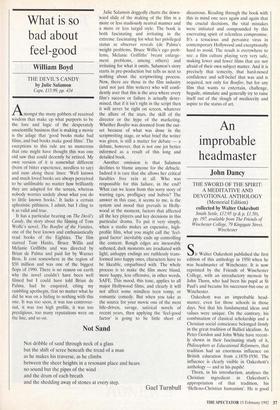What is so bad about feel-good
William Boyd
THE DEVIL'S CANDY by Julie Salamon Cape, £15.99, pp. 434 Amongst the many gobbets of received wisdom that make up what purports to be the lore and logic of the desperately unscientific business that is making a movie is the adage that 'good books make bad films, and bad books make good films'. The exceptions to this rule are so numerous that one might have thought this was one old saw that could decently be retired. My own version of it is somewhat different (born of bitter experience, needless to say) and runs along these lines: 'Well known and much loved books are always perceived to be unfilmable no matter how brilliantly they are adapted for the screen, whereas nobody worries unduly about what you do to little known books.' It lacks a certain aphoristic pithiness, I admit, but I cling to it as valid and true.
It has a particular bearing on The Devil's Candy, the story about the filming of Tom Wolfe's novel, The Bonfire of the Vanities, one of the best known and enthusiastically read books of the Eighties. The film starred Tom Hanks, Bruce Willis and Melanie Griffiths and was directed by Brian de Palma and paid for by Warner Bros. It cost somewhere in the region of $50 million and was one of the biggest flops of 1990. There is no reason on earth why the novel couldn't have been well filmed but I could have told Brian de Palma, had he enquired, citing my rambling apothegm. that no matter what he did he was on a hiding to nothing with this one. It was too soon, it was too controver- sial, it was too high profile, it was too prestigious, too many reputations were on the line, and so on. Julie Salamon doggedly charts the down- ward slide of the making of the film in a more or less studiously neutral manner and a more or less turgid style. The book is both fascinating and irritating in the extreme: fascinating for what her privileged status as observer reveals (de Palma's weight problems, Bruce Willis's ego prob- lems, Melanie Griffiths' breast enlarge- ment problems, among others) and irritating for what it omits. Salamon's story starts in pre-production but tells us next to nothing about the scriptwriting process. Now, there are those in the film industry (and not just film writers) who will confi- dently aver that this is the area where every film's success or failure is actually deter- mined, that if it isn't right in the script then it will never be right on screen, whatever the allure of the stars, the skill of the director or the hype of the marketing. Whether Bonfire was doomed from the out- set because of what was done in the scriptwriting stage, or what brief the writer was given, is still a matter for debate — a debate, however, that is not one jot better informed as a result of this long and detailed book.
Another omission is that Salamon declines to blame anyone for the debacle. Indeed it is rare that she allows her critical faculties free rein at all. Who was responsible for this failure, in the end? What can we learn from this sorry story of warring egos, profligacy and hubris? The answer in this case, it seems to me, is the system and mood that prevails in Holly- wood at the moment, factors that affected all the key players and key decisions in this particular drama. To put it very simply, when a studio makes an expensive, high- profile film, what you might call the 'feel- good factor' inevitably ends up controlling the content. Rough edges are inexorably softened, dark moments are irradiated with light, unhappy endings are ruthlessly trans- formed into happy ones, characters have to be likeable, empathised with. The whole process is to make the film more bland, more happy, less offensive, in other words, SAFE. This mood, this tone, applies to all major Hollywood films, and clearly it will not affect some mindless teen romp, or romantic comedy. But when you take as the source for your movie one of the most bile-driven, savage, satirical novels of recent years, then applying the 'feel-good factor' is going to be little short of
disastrous. Reading through the book with this in mind one sees again and again that the crucial decisions, the vital mistakes were initiated and compounded by this enervating spirit of relentless compromise. It's a tenacious and pervasive virus in contemporary Hollywood and exceptionally hard to avoid. The result is everywhere to see: a film culture playing very very safe, making fewer and fewer films that are not afraid of their own subject matter. And it is precisely that temerity, that hard-nosed confidence and self-belief that was and is required, not only for Bonfire, but for any film that wants to entertain, challenge, beguile, stimulate and generally try to raise itself out of the slough of mediocrity and aspire to the status of art.


























































 Previous page
Previous page